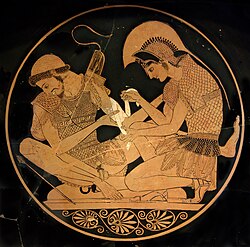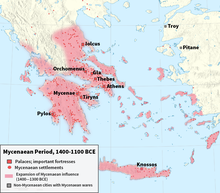Historicity of the Iliad
| Trojan War |
|---|
 |
The historicity of the Iliad has been a topic of scholarly debate for centuries. While researchers of the
History
Pre-modern views
In
The Trojan War continued to be regarded as essentially historical during the
Medieval Europeans continued to accept the Trojan War as historical, with dynasties often claiming descent from Trojan heroes.
Early modern views
In the early modern era, attitudes towards the legends grew more skeptical.
Modern scholarship
In the 1870s,
Since Schliemann, the site has been further excavated and reappraised numerous times, with particular attention to the layers which did coexist with the Mycenaeans, known collectively as Late Bronze Age Troy. Additional lines of research have included excavations at other sites such as Mycenae, examination of potential references to Troy in Hittite records, and philological study of the Iliad and Odyssey themselves. Despite these achievements, there remains no consensus for or against a real Trojan War, and some scholars regard the question as unanswerable.[9][10] [11]
Status of the Iliad
The more that is known about Bronze Age history, the clearer it becomes that it is not a yes-or-no question, but one of assessing of how much historical knowledge is present in Homer, and of what historical period. Finley concludes that it represents memories of
The narrative focus of the Iliad is not the strategy of the war, but the psychology of the warriors, assuming common knowledge of the Trojan War as a back-story. No scholars now hold that the specific events of the tale (many involving divine intervention) are historical fact; however, few claim that the story is entirely devoid of memories of Mycenaean times.[12]
The Iliad as essentially legendary

Some
Finley in The World of Odysseus presents a picture of the society represented by the Iliad and the Odyssey, avoiding the question as "beside the point that the narrative is a collection of fictions from beginning to end".[14]: 9 Finley was in a minority when his World of Odysseus first appeared in 1954. With the understanding that war was the normal state of affairs, Finley observed that a ten-year war was out of the question, indicating Nestor's recall of a cattle-raid in Elis as a norm, and identifying the scene in which Helen points out to Priam the Achaean leaders in the battlefield, as "an illustration of the way in which one traditional piece of the story was retained after the war had ballooned into ten years and the piece had become rationally incongruous".[14]: 46
Finley, for whom the Trojan War is "a timeless event floating in a timeless world",[14]: 172 analyzes the question of historicity, aside from invented narrative details, into five essential elements: 1. Troy was destroyed by a war; 2. the destroyers were a coalition from mainland Greece; 3. the leader of the coalition was a king named Agamemnon; 4. Agamemnon's overlordship was recognized by the other chieftains; 5. Troy, too, headed a coalition of allies. Finley does not find any evidence for any of these elements.[14]: 175ff.
Aside from narrative detail, Finley pointed out that, aside from some correlation of Homeric placenames and Mycenaean sites,[note 2] there is also the fact that the heroes lived at home in palaces (oikoi) unknown in Homer's day; far from a nostalgic recall of the Mycenaean age, Finley asserts that "the catalog of his errors is very long".
His arms bear a resemblance to the armour of his time, quite unlike the Mycenaean, although he persistently casts them in antiquated bronze, not iron. His gods had temples, and the Mycenaeans built none, whereas the latter constructed great vaulted tombs to bury their chieftains in and the poet cremates his. A neat little touch is provided by the battle chariots. Homer had heard of them, but he did not really visualize what one did with chariots in a war. So his heroes normally drove from their tents a mile or less away, carefully dismounted, and then proceeded to battle on foot.[14]: 45
What the poet believed he was singing about was the heroic past of his own Greek world, Finley concludes.
During recent years scholars have suggested that the Homeric stories represented a synthesis of many old Greek stories of various Bronze Age sieges and expeditions, fused together in the Greek memory during the "
It is also worth comparing the details of the Iliadic story to those of older Mesopotamian literature—most notably, the Epic of Gilgamesh. Names, set scenes, and even major parts of the story, are strikingly similar.[15] Some academics believe that writing first came to Greece from the east, via traders, and these older poems were used to demonstrate the uses of writing, thus heavily influencing early Greek literature.
The Iliad as essentially historical

Another opinion is that Homer was heir to an unbroken tradition of oral epic poetry reaching back some 500 years into Mycenaean times. The case is set out in
The Iliad as partly historical
As mentioned above, though, it is most likely that the Homeric tradition contains elements of historical fact and elements of fiction interwoven. Homer describes a location, presumably in the
Hittite evidence
The Hittite placenames
A number of Hittite documents attest to ongoing political turmoil in Western Anatolia which affected Wilusa on occasion. Notable among these documents are the
Homeric evidence

Also, the
Mycenaean evidence
Likewise, in the Mycenaean Greek Linear B tablets, some Homeric names appear, including Achilles (Linear B: 𐀀𐀑𐀩𐀄, a-ki-re-u),[note 3] a name which was also common in the classical period, noted on tablets from both Knossos and Pylos.[28] The Achilles of the Linear B tablet is a shepherd, not a king or warrior, but the very fact that the name is an authentic Bronze Age name is significant. These names in the Homeric poems presumably remember, if not necessarily specific people, at least an older time when people's names were not the same as they were when the Homeric epics were written down. Some story elements from the tablets appear in the Iliad.[29]
Geological evidence
In November 2001, geologist John C. Kraft from the University of Delaware presented the results of investigations into the geology of the region that had started in 1977. The geologists compared the present geology with the landscapes and coastal features described in the Iliad and other classical sources, notably Strabo's Geographia. Their conclusion was that there is regularly a consistency between the location of Troy as Hisarlik (and other locations such as the Greek camp), the geological evidence, and descriptions of the topography and accounts of the battle in the Iliad.[30][31]
See also
- Historical Troy uncovered
- Homeric Question
- Geography of the Odyssey
- Sources and parallels of the Exodus
Notes
- ISBN 0563522658.
- ^ "Although the poverty of the finds in Odysseus's Ithaca is one of the notable exceptions".[14]: 44
- ^ The word a-ki-re-u which is found on the KN Vc 106 tablet, has been identified as Akhilleus.
References
- ^ ISBN 978-0-415-34959-8.
- ISBN 978-1-59017-017-5.
- ^ Eusebius' chronological tables are re-analysed in depth by Richard W. Burgess, Witold Witakowski, eds.Studies in Eusebian and Post-Eusebian Chronography vol. 1. (Stuttgart) 1999; see Introduction and Overview
- ^ Analysed in Francis Ingledew, "The Book of Troy and the Genealogical Construction of History: The Case of Geoffrey of Monmouth's Historia regum Britanniae" Speculum 69,.3 (July 1994:665–704).
- ^ Peter G. Bietenholz, Historia and Fabula: Myths and Legends in Historical Thought 1994:190.
- ^ Pascal, Pensées (published 1660), part ix, §628.
- ^ In Grote, A History of Greece, vol. I (1846), "Legendary Greece" prefaces "Historical Greece to the reign of Peisistratus", and begins the "historical" section with the traditional date of the first Olympiad, 776 BC: "To confound together these disparate matters is, in my judgement, essentially unphilosophical. I describe the earlier times by themselves, as conceived by the faith and feeling of the first Greeks, and known only through their legends,—without presuming to measure how much or how little of historical matter these legends may contain" (Preface). The "Legend of Troy"—"this interesting fable"—fills his chapter xv.
- ISBN 978-0-415-34959-8.
- ^ "Rutter, Jeremy B., "Troy VII and the Historicity of the Trojan War", Dartmouth College". Archived from the original on 2014-04-07. Retrieved 2014-12-15.
- ISBN 978-0-415-34959-8.
- .
So where is history in all this? I have no doubt that something (or perhaps many things) that we might just call real history in some sense of the word is there, lurking in the palimpsest of Homeric oral prehistory. But the question of whose history, and when and where, is something we can probably never untangle; and I do not believe we can find the answer to these questions either by looking in the ground or by analysing ancient historical texts...
- ISBN 9780801846571.
- ^ West, Martin L., "Academic spat over Troy project", The Times, 20 August 2001
- ^ ISBN 9780140205701.
- ^ Martin West, The East Face of Helicon (Oxford 1999), pp. 336-338; T.B.L. Webster, From Mycenae to Homer (London 1958) pp. 82, 119ff.
- ^ "5. Homer as an Oral-Traditional Poet". chs.harvard.edu. Retrieved 2019-01-19.
- ISBN 9780563201618.
- ^ Wood (1985) p142
- ^ ISBN 978-0-415-34959-8.
- ISBN 978-1589832688.
- ISBN 978-0-415-34959-8.
- ISBN 9780415394857.
- ^ Bryce, Trevor (1998). The Kingdom of the Hittites. Oxford: Clarendon Press.
- ISBN 978-1589832688.
- ISBN 978-1589832688.
- ^ Gladstone, William Ewart (1881). "Geography". Homer. New York: D. Appleton & Company. pp. 57–64.
- ISSN 0261-3077. Retrieved 2019-01-19.
- ISBN 0-313-32526-X.
- ISBN 0-415-24923-6.
- ^ Thomas, Neil. "Geology corresponds with Homer's description of ancient Troy". University of Delaware. Retrieved 14 January 2022.
- EurekAlert!. American Association for the Advancement of Science. Retrieved 14 January 2022.
